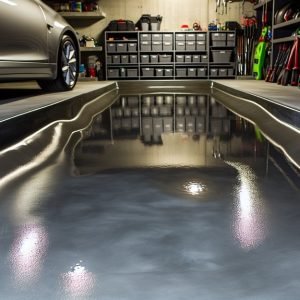Last Updated on November 18, 2025 by teamobn
Love spending time in your yard and camping outdoors? A homemade wood-burning stove can give you free heat, a simple way to cook, and a great excuse to sit around a fire with family and friends.
What Is a Homemade Wood-Burning Stove?
A homemade wood-burning stove is a compact heater or cooker you build from basic materials like gas bottles, scrap metal, bricks, or cans to burn wood efficiently.
Many DIY designs — such as rocket stoves, wood‑gas stoves, and mass heaters — use insulated chambers and a vertical chimney or flue to improve combustion, reduce smoke, and squeeze as much heat as possible from small pieces of wood.
Most DIY stoves are best used outdoors or in very well‑ventilated areas, and all should follow local safety and building guidelines.
The projects below are mostly built from upcycled or scrap materials, so they’re inexpensive and environmentally friendly. They come in different shapes and sizes, but all are perfect for cooking outside and keeping warm on cold evenings.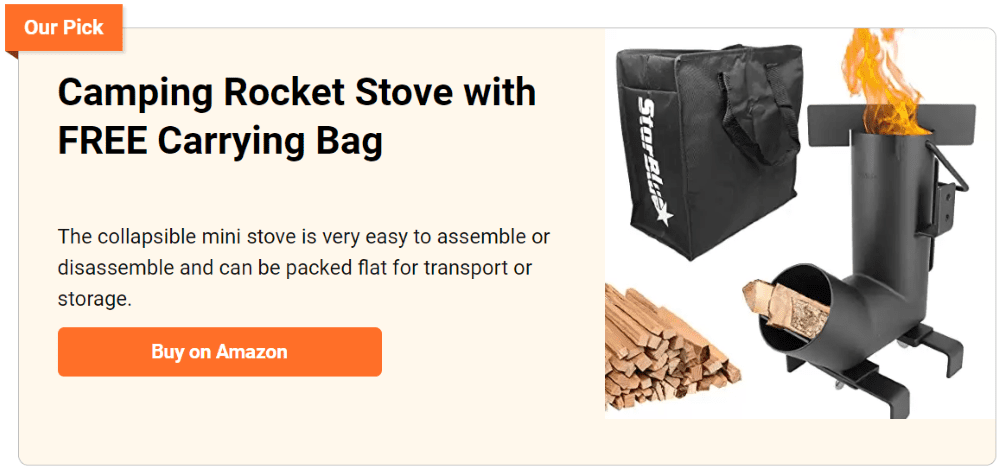
What is a rocket stove?
A rocket stove is one of the most popular and efficient styles of DIY wood stove, so it’s worth understanding the basics before you choose a design.
A rocket stove is a highly efficient wood-burning stove with an L‑shaped combustion chamber and a tall, insulated chimney that creates a strong draft. It burns small sticks and twigs at very high temperatures, which means less smoke, less fuel, and more heat.
Key features of a rocket stove:
- Side feed tube where you insert small sticks or twigs
- Vertical burn chamber and chimney that create the “rocket” draft
- Insulation around the burn chamber to keep temperatures high
- Simple pot stand or cooking surface above the chimney
Compared with a campfire, a rocket stove boils water faster, uses far less wood, and produces a cleaner burn — making it ideal for camping, off‑grid living, and emergency cooking.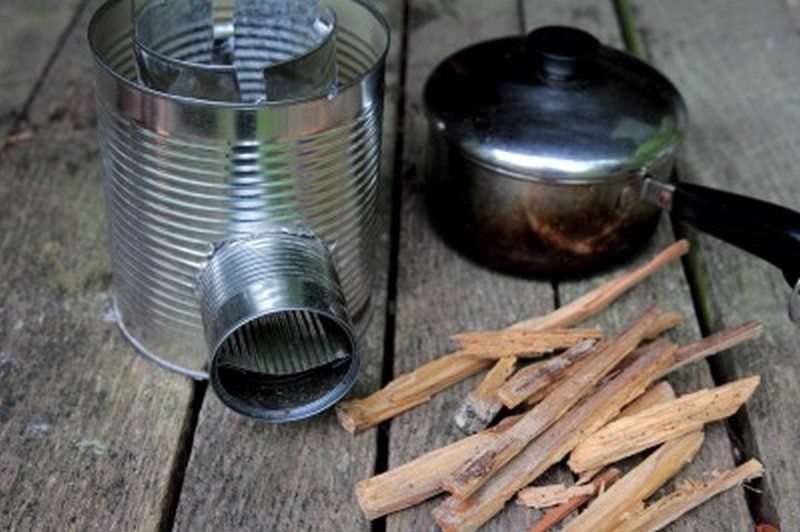
Click on any image to start the lightbox display of our homemade wood stove plans. Use your Esc key to close the lightbox. You can also view the images as a slideshow if you prefer ![]()
12 DIY Wood Burning Stove Ideas
Vader Gas Bottle Log Burner
The Vader Gas Bottle Log Burner is a standout choice for fans of unique, themed wood burning stoves. Crafted from a repurposed gas bottle, this wood burning stove is designed to resemble the iconic helmet of Darth Vader, making it a must-have for Star Wars enthusiasts.
The Vader Gas Bottle Log Burner is a show‑stopping piece for any Star Wars fan. Made from an old gas bottle cut and shaped into Darth Vader’s iconic helmet, it’s both a functional log burner and a conversation starter.
- Best for: Backyard entertaining, fire feature, casual outdoor heating
- Skill level: Intermediate – requires metal cutting, welding, and grinding
- Materials: Empty gas bottle, steel plate, hinges, grate, high‑temp paint
- Why it’s great: You’re upcycling a gas cylinder into a durable wood stove that gives plenty of heat and a dramatic glow when lit.
Always make sure gas bottles are completely empty and safely purged before cutting.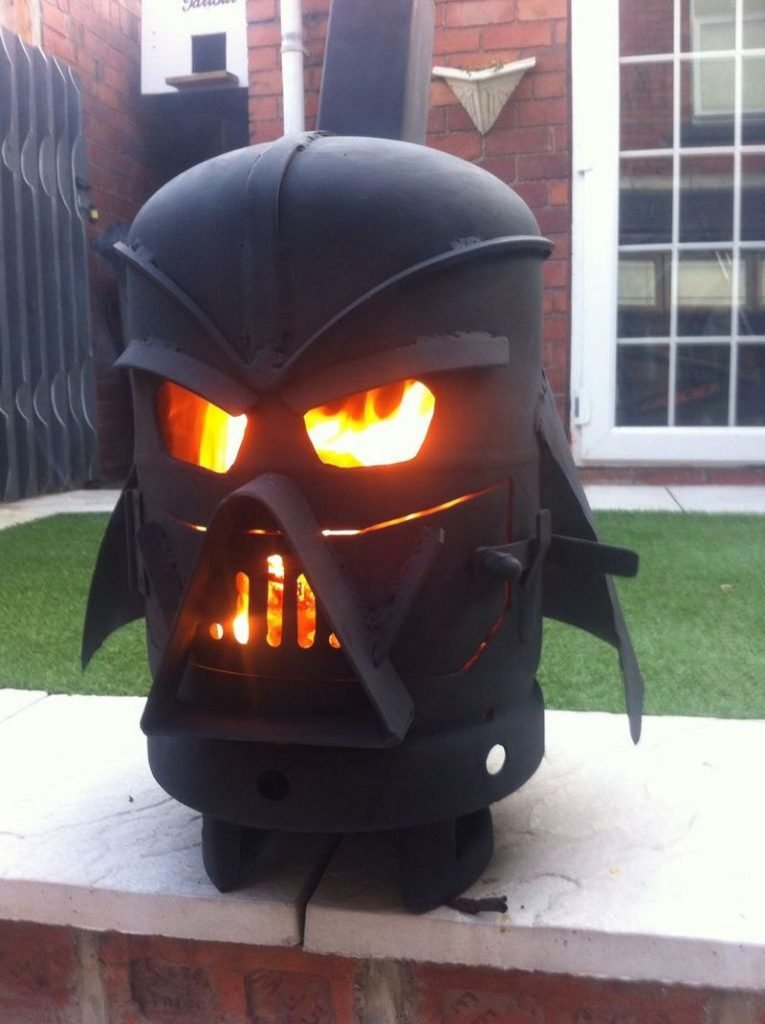

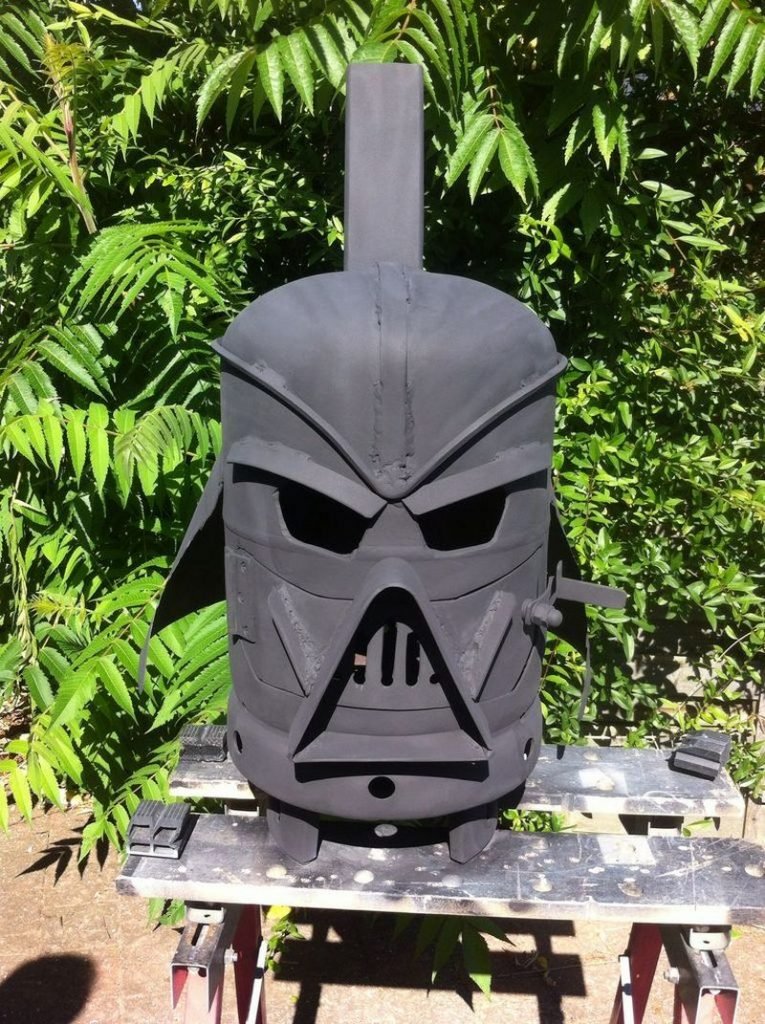
DIY Portable Tin Can Rocket Stove
A DIY tin can rocket stove is a simple, ultra‑cheap project that turns a couple of cans into a surprisingly powerful little cooker.
- Best for: Camping, hiking, emergency kits, ultra‑budget setups
- Skill level: Beginner
- Materials: Large tin can, one or two smaller cans, metal snips, drill, wire or simple pot stand
- Why it’s great: It runs on twigs and small offcuts, packs down small, and can boil water or cook a one‑pot meal with minimal fuel.
Basic steps:
- Cut a hole near the base of the large can for the side fuel feed.
- Insert a smaller can or metal tube to form the L‑shaped burn chamber.
- Punch air holes near the top to improve airflow.
- Add a pot stand on top and test outside using only dry wood.
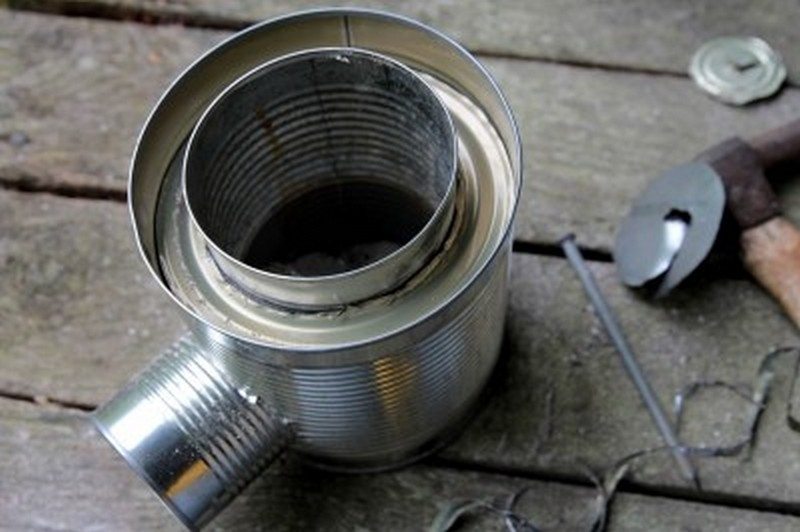

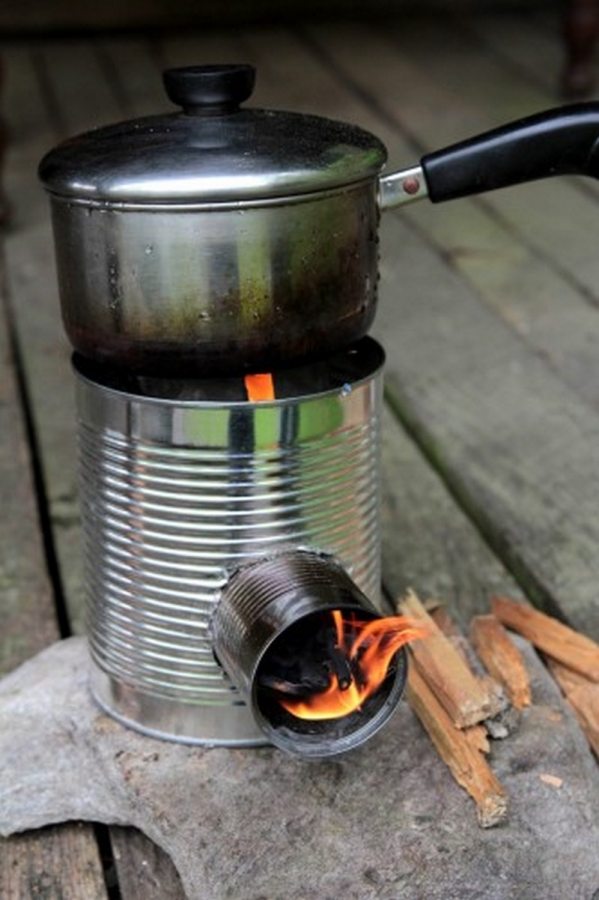
Heavy‑Duty Propane Tank Rocket Stove
If you want something more permanent, a rocket stove built from an old propane tank is tough, efficient, and built to last.
- Best for: Backyard cooking, off‑grid setups, outdoor kitchens
- Skill level: Intermediate to advanced – needs cutting, welding, and safe handling of tanks
- Materials: Empty propane tank, steel pipe, plate for cooking surface, insulating material (e.g., perlite, vermiculite, or firebrick)
- Why it’s great: Once built, it’s highly efficient, very robust, and can support heavier pots and pans.
Propane tanks must be fully depressurized, purged, and handled with extreme care before you cut into them.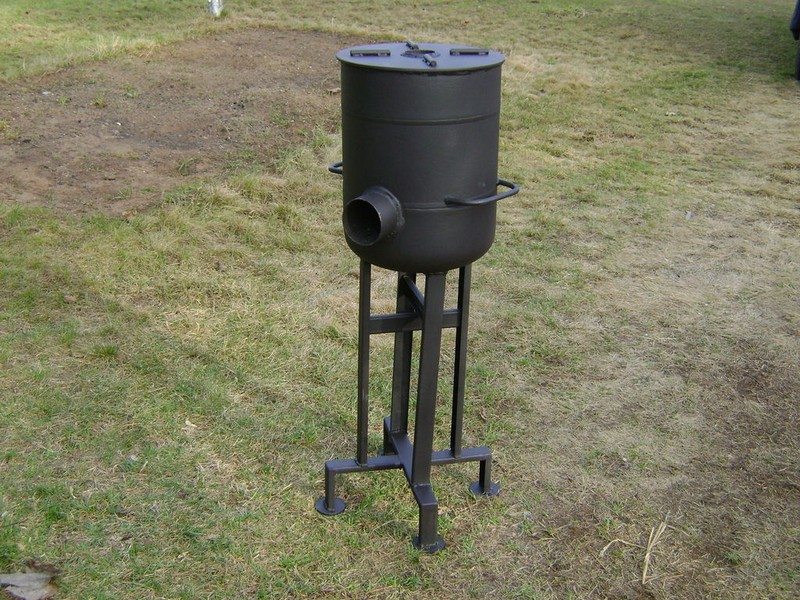
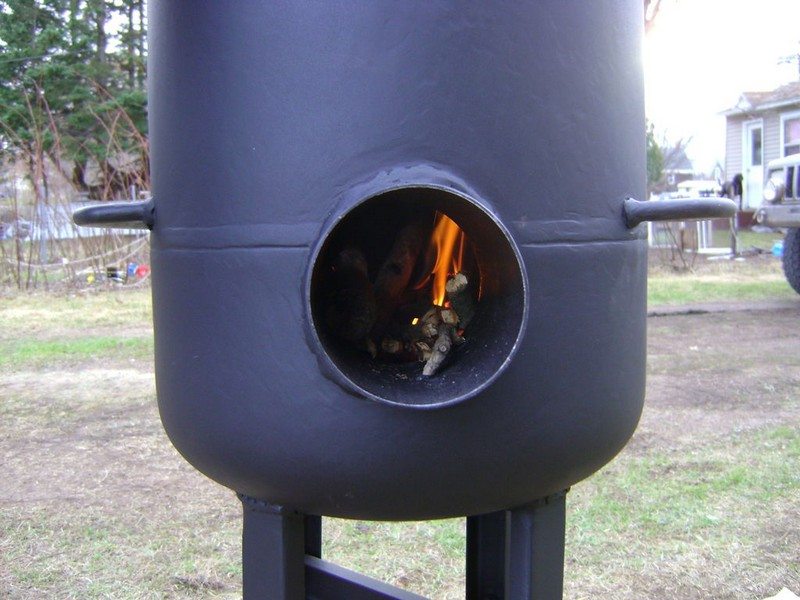

Concrete Rocket Stove
A rocket stove cast from concrete creates a solid, almost permanent outdoor cooker.
- Best for: Fixed outdoor cooking area, garden kitchen, survival setups
- Skill level: Intermediate – basic concrete work and form building
- Materials: Heat‑resistant concrete mix, forms or molds, steel or firebrick for the burn tunnel, chimney insert
- Why it’s great: Concrete handles high temperatures, holds heat well, and doesn’t catch fire. The mass helps radiate warmth even after the fire dies down.
Use high‑temperature, appropriate concrete and ensure the design allows for expansion and heat without cracking.

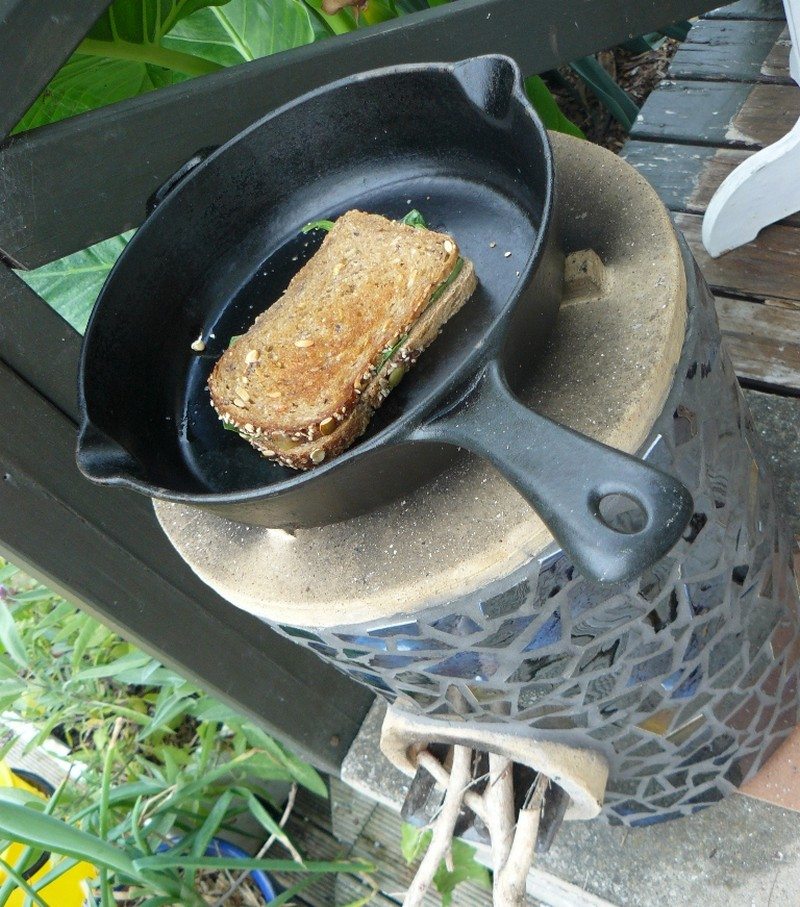
Stainless Steel Garden Incinerator – Patio Heater
A stainless steel garden incinerator can double as a simple outdoor heater and cooktop when used carefully.
- Best for: Burning garden waste, occasional outdoor heating, rustic cooking
- Skill level: Beginner (if using a pre‑made incinerator)
- Materials: Stainless steel incinerator bin with lid, fire grate, simple pot stand or grill
- Why it’s great: It’s inexpensive, portable, and can tackle yard waste while providing heat and a basic cooking surface.
Use only outdoors on a non‑flammable surface, and never burn hazardous materials or use as a closed stove indoors.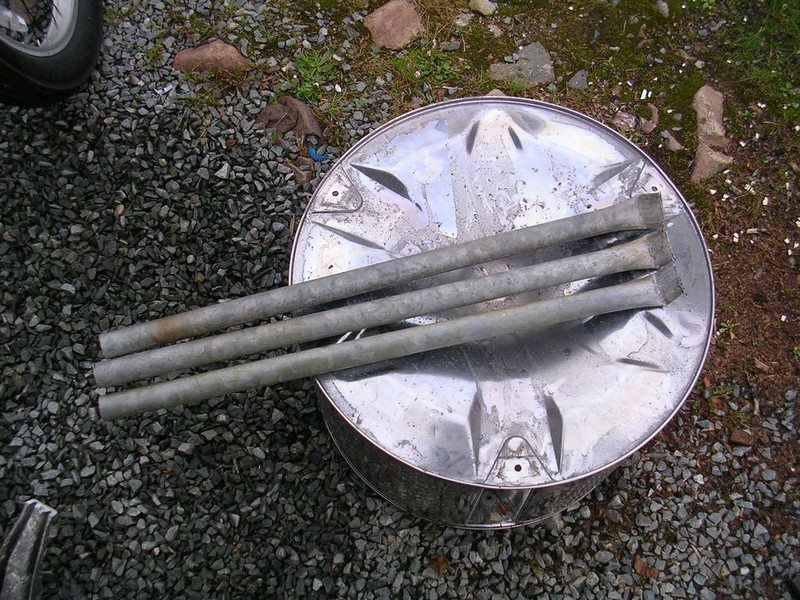
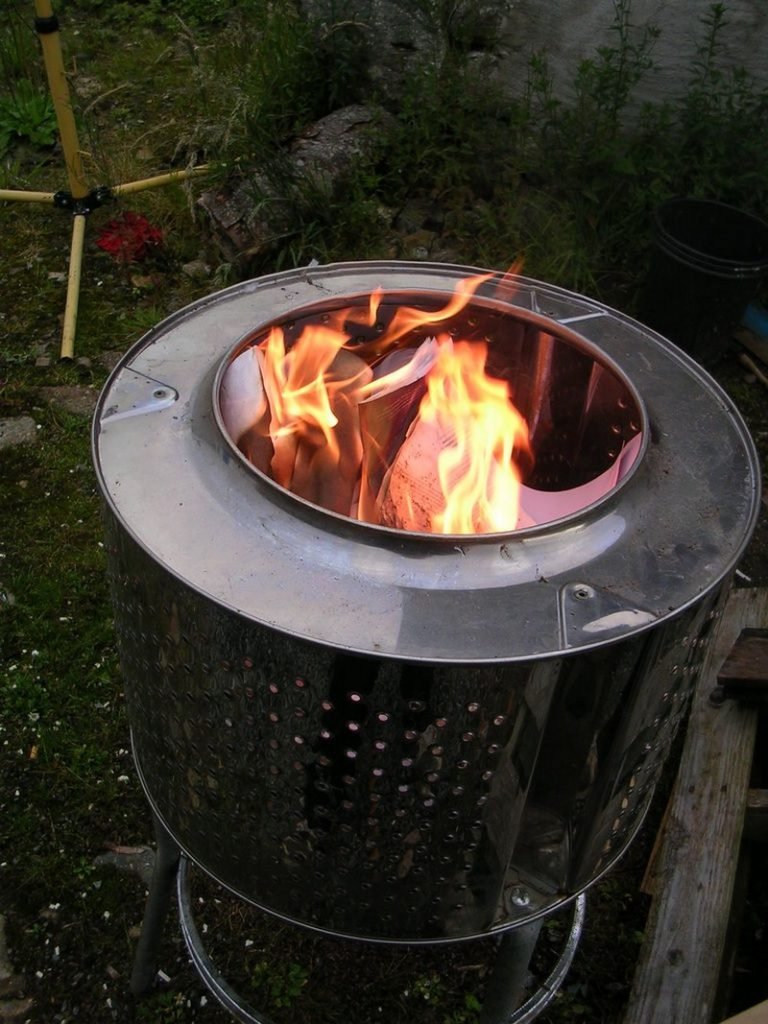
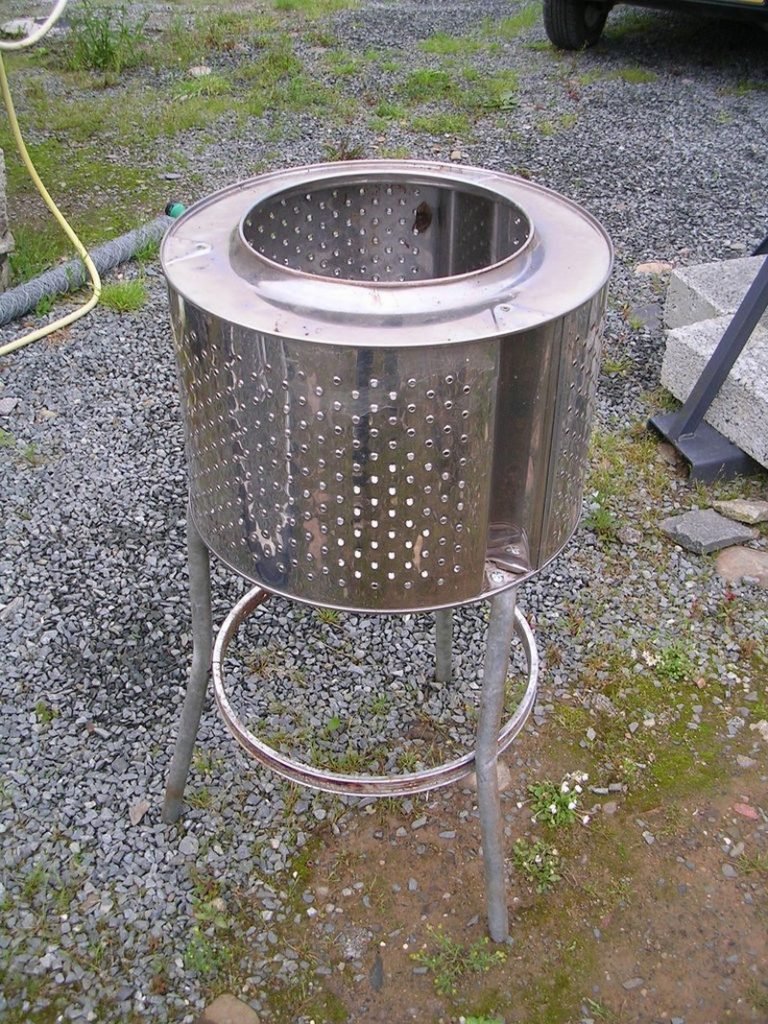
Homemade Mass Heater
A homemade mass heater, often called a rocket mass heater, stores heat in a large “thermal mass” so it can release gentle warmth for hours.
- Best for: Greenhouses, workshops, off‑grid cabins (where codes allow), covered outdoor spaces
- Skill level: Advanced – requires careful design and understanding of flue gases
- Materials: Rocket‑style burn chamber, cob or masonry for the bench or mass, flue pipes, chimney
- Why it’s great: It burns wood very efficiently, then channels the hot exhaust through a long bench or mass that slowly releases heat.
These systems must be built with safety, draft, and local regulations in mind. Consider professional advice for any indoor installation.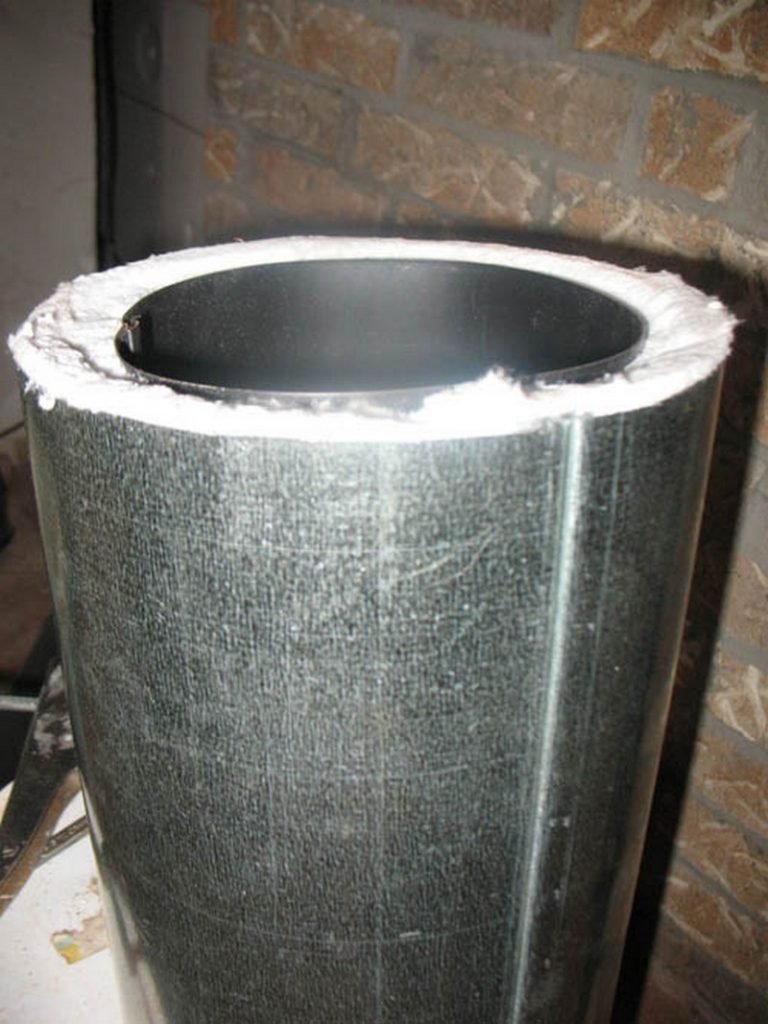


DIY Wood Gasification Stove
A wood gasification stove (or wood‑gas stove) burns wood twice — by first turning it into combustible gases, then burning those gases at high temperature.
- Best for: Clean outdoor cooking, camping, survival kits
- Skill level: Intermediate
- Materials: Nested metal cans or cylinders, air holes at different levels, pot support
- Why it’s great: Once it’s hot, it produces a near‑smokeless flame and excellent heat from small amounts of fuel.
These are ideal where smoke is an issue and you want a clean, hot flame for cooking.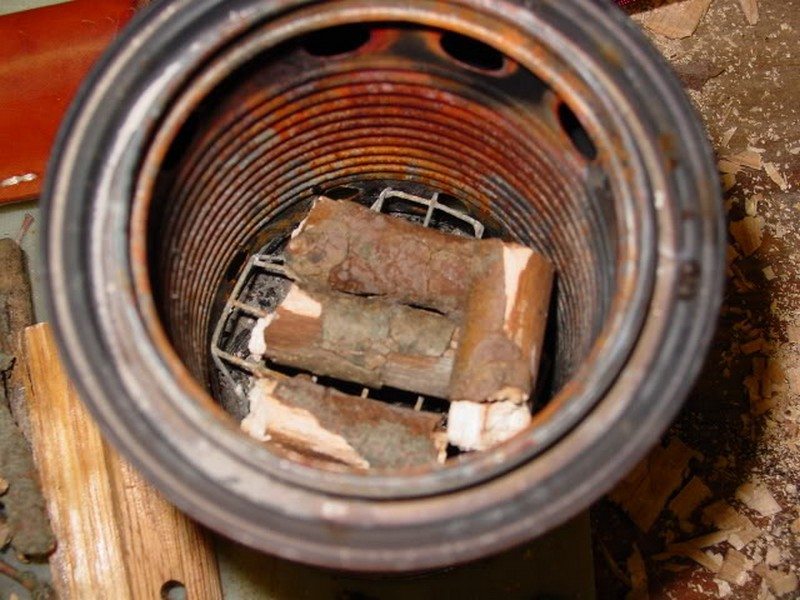


Wood Stove Made from Scrap
A scrap‑built wood stove is where creativity really shines. Using offcuts of steel, old pipes, and plate, you can build a stove that perfectly fits your space.
- Best for: Workshops, sheds, outdoor cooking spaces
- Skill level: Intermediate to advanced – welding and metal fabrication
- Materials: Scrap steel plate, pipe for chimney, old hinges, grate materials
- Why it’s great: You divert metal from the waste stream and end up with a unique, functional heater.
Keep indoor use strictly compliant with local codes; many scrap stoves are best kept outdoors to avoid safety and insurance issues.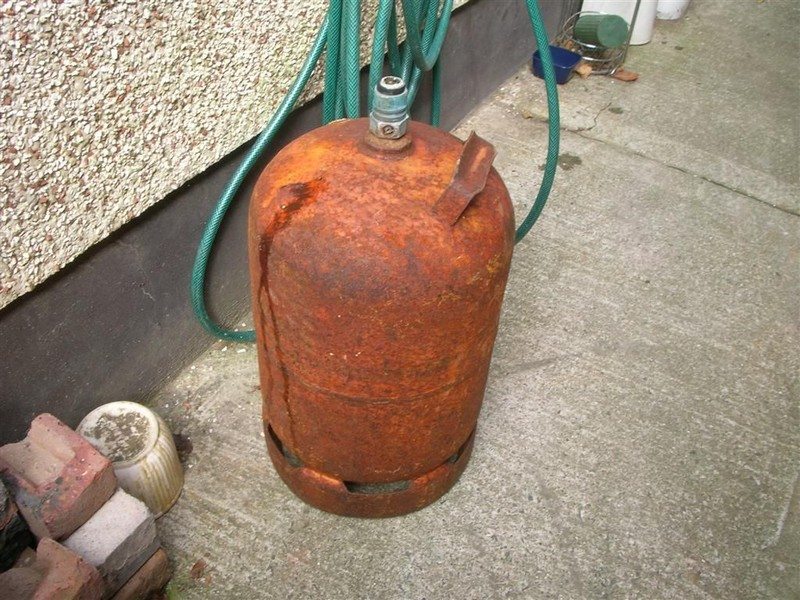

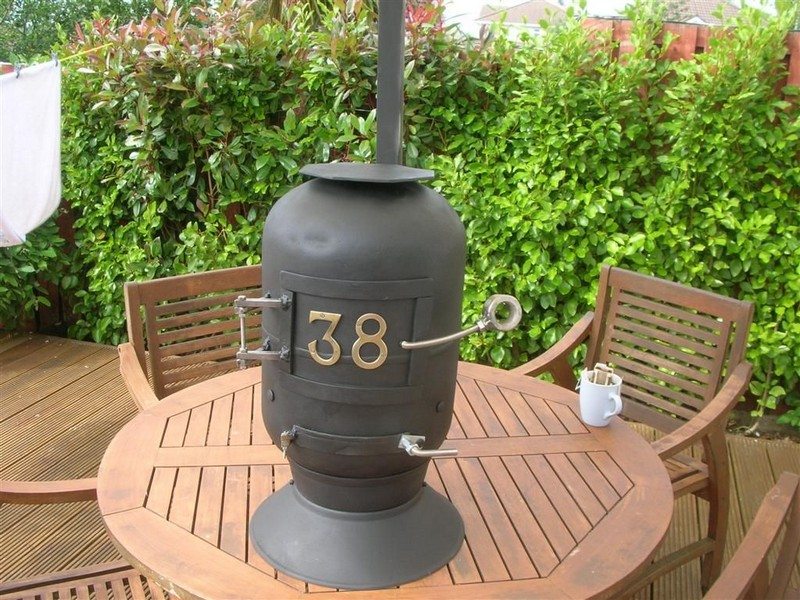
Handmade Wood Burning Stove
A fully handmade wood-burning stove lets you control everything: firebox size, chimney position, cooking surface, and overall look.
- Best for: Custom outdoor cooking station, rustic patios, off‑grid setups
- Skill level: Advanced – design, welding, and safety considerations
- Materials: New or reclaimed steel, glass door (optional), firebrick, chimney components
- Why it’s great: You can tailor the stove to your pots, benches, and space, and turn it into a centerpiece as well as a heater.
Handmade doesn’t mean unsafe — build with proven stove principles and follow best practices.
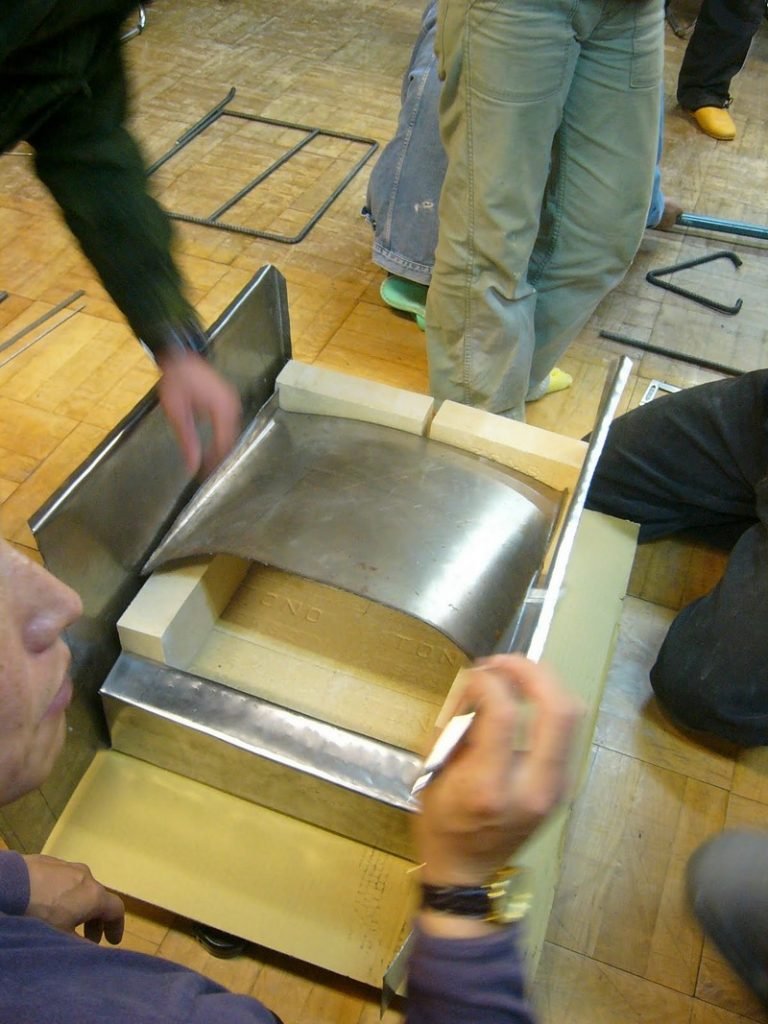
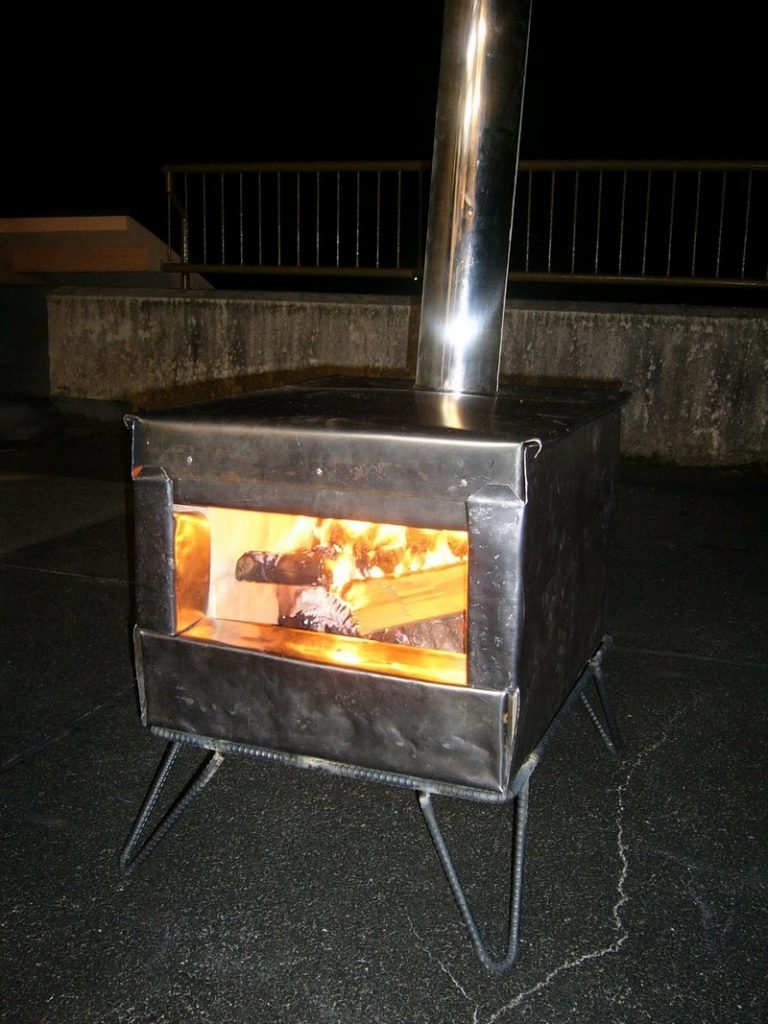
Wood‑Gas Camp Stove
A wood‑gas camp stove is a compact, portable version of a gasification stove designed specifically for hikers and campers.
- Best for: Backpacking, bushcraft, minimalist camping
- Skill level: Beginner to intermediate (depending on design)
- Materials: Lightweight stainless steel body, inner and outer walls, air holes, pot supports
- Why it’s great: It packs small, weighs little, and runs on twigs, pinecones, and tiny sticks you can gather on the trail.
Many commercial designs exist, but you can also build your own using nested cans and careful hole placement.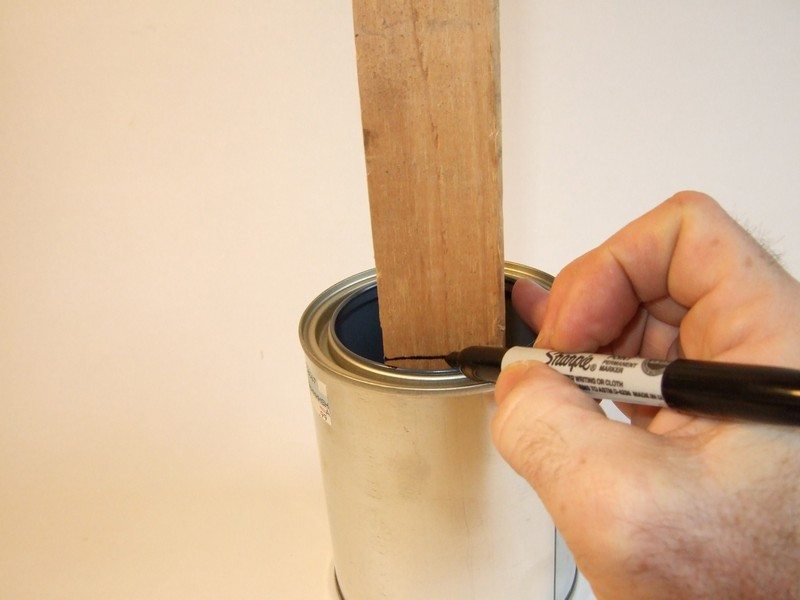
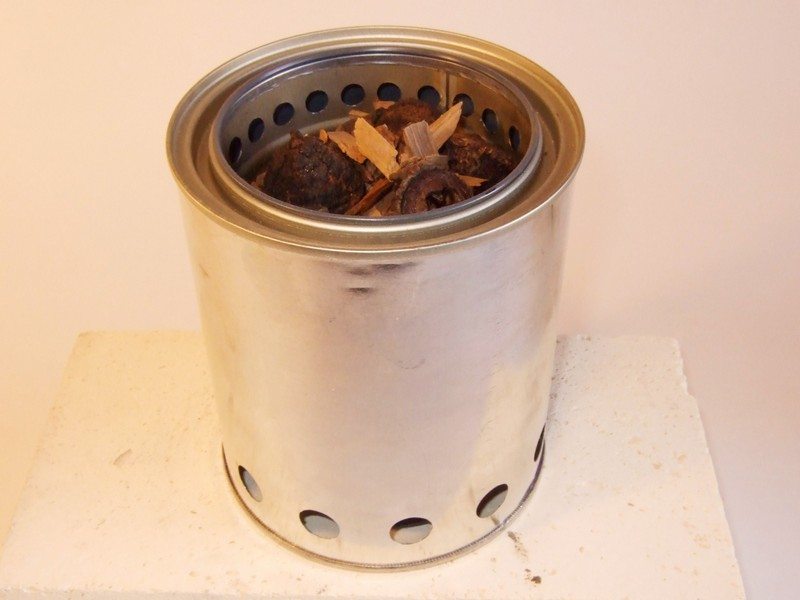
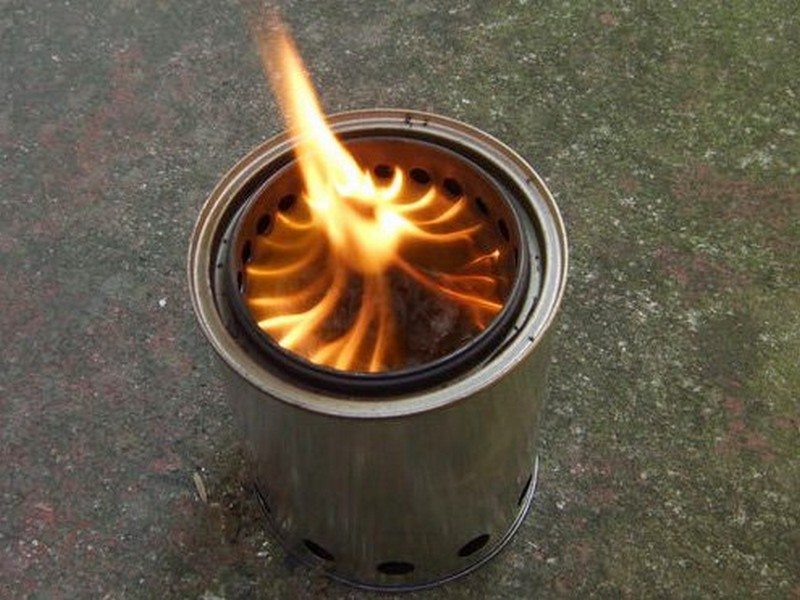
The Deadwood Rocket Stove for Cooking Indoors (or in Sheltered Spaces)
The Deadwood‑style rocket stove is designed as a high‑efficiency cooking stove with a vertical insulated chimney and stable pot support.
- Best for: Covered outdoor kitchens, off‑grid cabins with proper ventilation
- Skill level: Intermediate
- Materials: Heavy steel body, insulated burn tunnel, pot support, optional side handles
- Why it’s great: It’s fuel‑efficient, burns hot with little smoke, and is built for everyday cooking with minimal wood.
Only use indoors where local codes allow, and always with adequate ventilation and a proper chimney system.

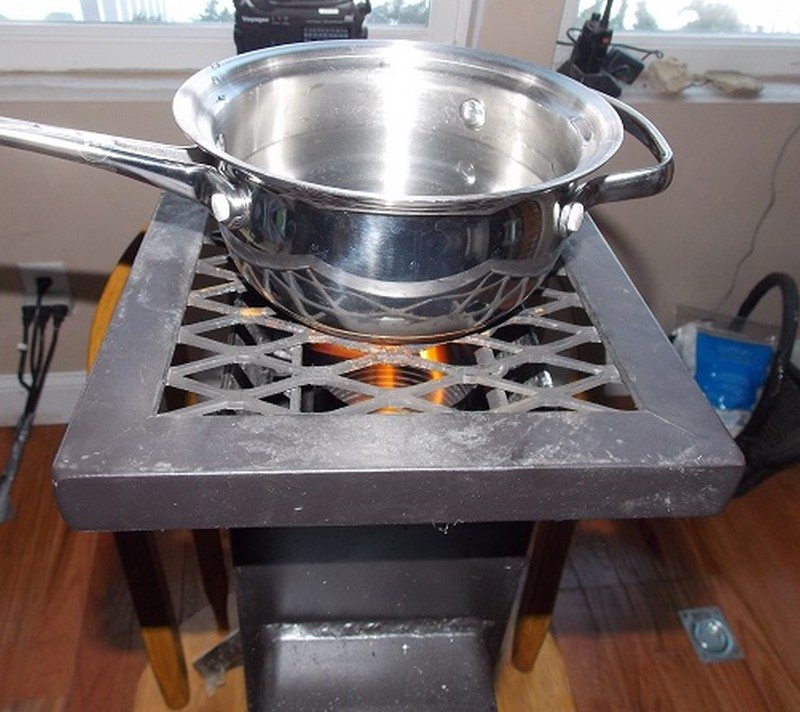
Recycled Rim BBQ Fire Pit
A recycled rim fire pit uses old car or truck wheel rims welded together to make a durable outdoor stove and grill.
- Best for: BBQs, marshmallow roasts, general backyard fires
- Skill level: Beginner to intermediate
- Materials: Steel wheel rims, simple legs or base, optional grill grate
- Why it’s great: It’s incredibly sturdy, cheap to build, and perfect for open‑fire cooking or just enjoying the flames.
As with all open fire pits, keep it on a fireproof surface and away from structures and overhanging branches.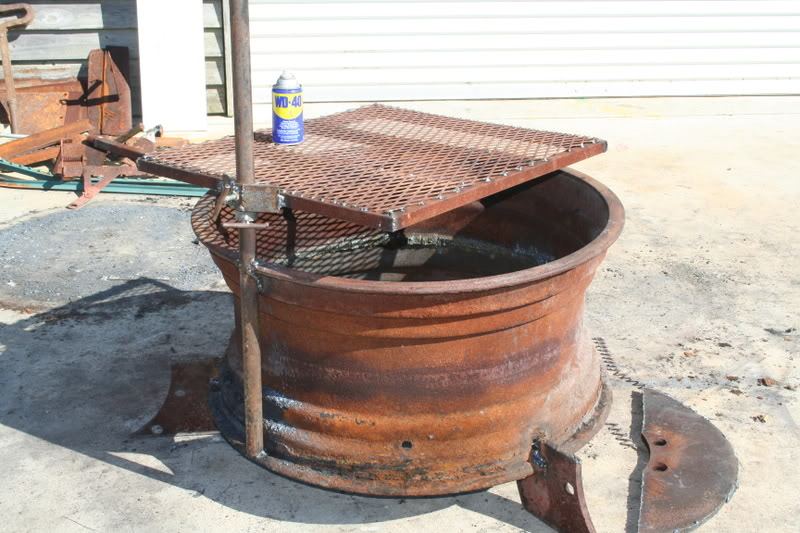
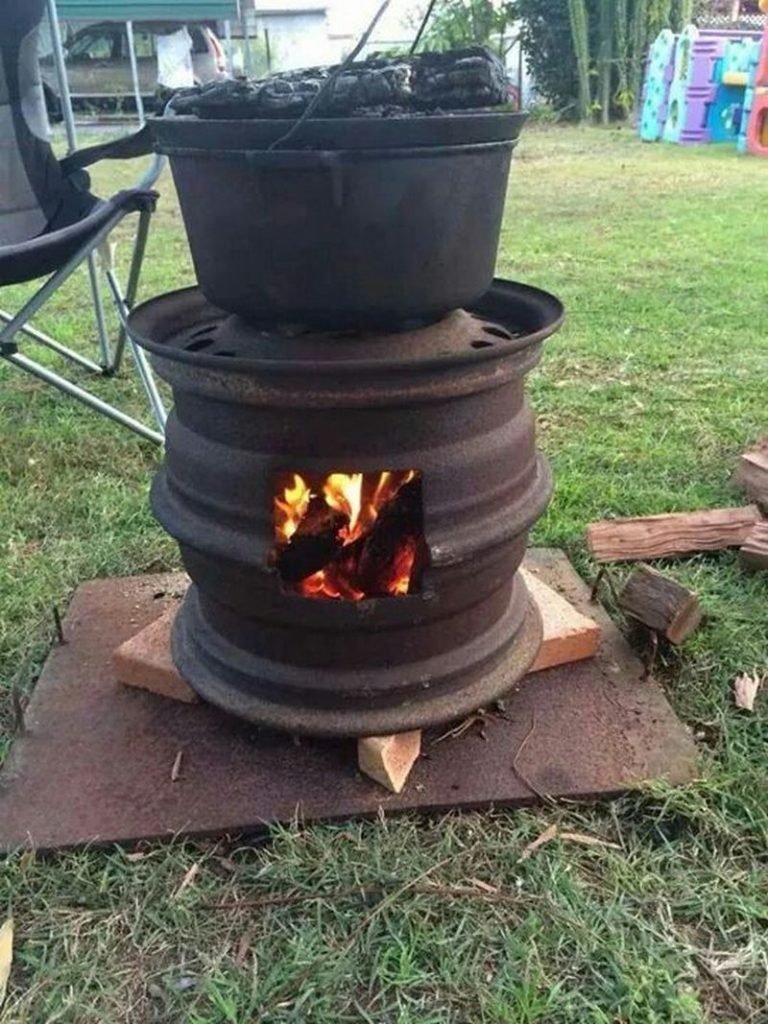

If you liked these, you will also like viewing these easy DIY projects…
How to Use a Wood Burning Stove Safely
Wood-burning stoves are cozy, efficient, and fun — but they must be used with care. Proper installation, good ventilation, and regular maintenance are non‑negotiable if you want warmth without risk.
- Install Properly
- Have any permanent or indoor stove installed or checked by a qualified professional. Correct clearances, chimney design, and fire‑proof surroundings are essential to prevent chimney fires and heat damage.
- Maintain Your Stove and Chimney
- Inspect your stove body, seals, and doors regularly for cracks or wear. Make sure your chimney or flue stays clear of creosote and blockages, and have it professionally cleaned at least once a year if you use the stove often.
- Use the Right Fuel
- Burn only dry, seasoned hardwood where possible. Avoid wet wood, painted or treated timber, plywood, MDF, plastics, or household rubbish — these can create excessive smoke, toxic fumes, and heavy creosote deposits.
- Ventilation is Critical
- Every wood stove needs a safe way for smoke and gases to leave. Outdoors, this means giving the stove space and never using it inside tents or enclosed vehicles. Indoors, it means a proper chimney or flue, enough make‑up air, and ideally a carbon monoxide detector in the same area.
- Keep the Area Clear
- Maintain at least a three‑foot (one‑metre) clearance between the stove and anything flammable — curtains, furniture, stored wood, and soft furnishings. Use a fireproof hearth or base under the stove.
- Educate Everyone Who Uses the Stove
- Make sure family members and guests know how to light, refuel, and shut down the stove safely, and what to do in an emergency.
- Have Safety Gear Ready
- Keep a suitable fire extinguisher nearby, along with a bucket of sand or water for outdoor setups. Test smoke alarms and carbon monoxide detectors regularly.
- Dispose of Ash Safely
- Ashes can stay hot long after the fire looks out. Store them in a metal container with a tight‑fitting lid, on a non‑flammable surface, well away from structures and combustible materials.
- Protect Children and Pets
- Use a guard or barrier around stoves when children or pets are around. The metal surfaces stay dangerously hot for a long time after the fire is out.
How to Source Wood Sustainably for Your Stove
When you burn wood thoughtfully, a wood stove can be part of a sustainable heating or cooking setup.
- Choose certified or responsibly harvested wood
- Where available, look for wood from responsibly managed forests. Certification schemes and local forestry programs help ensure trees are harvested and replanted sensibly.
- Source locally
- Buying wood locally or collecting from your own property lowers the carbon footprint from transport and supports local suppliers.
- Use seasoned wood
- Seasoned wood is split and dried for at least six months to a year. It burns hotter and cleaner, with less smoke and creosote, which is better for your stove, your chimney, and your neighbours.
- Repurpose and recycle
- Offcuts from building projects, storm‑fallen branches, and waste from sawmills can all be excellent fuel — as long as the wood is untreated and dry.
- Give back with tree planting
- Plant trees on your property or support tree‑planting initiatives to help replace what you burn over time.
FAQ About Wood Burning Stoves
- How efficient are wood-burning stoves?
- Modern wood-burning stoves and well‑designed rocket or gasification stoves can reach efficiencies of 70% or more. That means more of the wood’s energy turns into usable heat instead of smoke.
- Can I install a wood-burning stove without a chimney?
- Yes, in some cases you can install a stove using a properly designed twin‑wall flue system that vents through a wall or roof instead of a traditional chimney. Always follow local building codes and manufacturer instructions.
- What is the best wood to burn?
- Dry, seasoned hardwoods such as oak, ash, and beech burn longer and hotter than most softwoods. Whatever you use, make sure it’s dry and untreated.
- Are homemade wood-burning stoves safe to use indoors?
- Most homemade stoves are best kept outdoors. Using a DIY stove indoors can be dangerous unless it’s been professionally designed, installed, and approved to meet local regulations. Carbon monoxide and fire risk are serious concerns.
- Are wood-burning stoves bad for the environment?
- Wood burning can be relatively low‑carbon if the wood is sourced sustainably and burned efficiently in a modern or well‑designed stove. Poorly seasoned wood, smoky fires, and old, inefficient stoves create more pollution.
- How can I improve the efficiency of my stove?
- Burn only dry, seasoned wood, run the stove hot enough for clean combustion, and keep the stove and chimney clean. Good seals, a well‑designed flue, and using the air controls correctly also help.
- Can I cook on my wood-burning stove?
- Yes. Many wood stoves are designed with a flat top or grill for cooking. Even improvised designs like rocket stoves and rim fire pits work well for boiling water and one‑pot meals.
- What safety equipment should I have?
- At a minimum, keep a suitable fire extinguisher, working smoke alarms, and a carbon monoxide detector. If you have children or pets, add a sturdy fire guard.
- What should I look for when choosing a wood-burning stove design?
- Check efficiency, emissions, and the type of fuel the stove is designed for. Consider whether you want primarily heating, cooking, or both, and whether the stove will be used indoors (subject to codes) or strictly outdoors.
- Can a wood-burning stove be left burning overnight?
- Some stoves are designed to be safely run overnight when loaded correctly and used according to the manufacturer’s instructions. Never overload a stove or leave a fire unattended if you’re unsure of its design and safety.
Conclusion
Homemade wood-burning stoves and heaters are a rewarding DIY project that can turn scrap materials into serious heat and great food. Whether you choose a simple tin can rocket stove for camping, a heavy‑duty propane tank build for your backyard, or a recycled rim fire pit for gatherings, the same rules apply: build thoughtfully, burn cleanly, and always put safety first.




